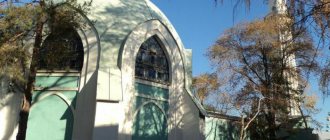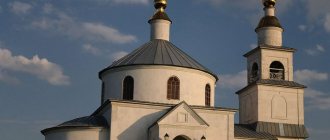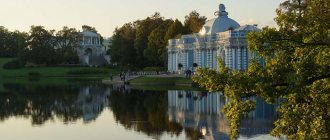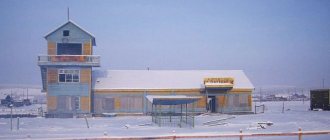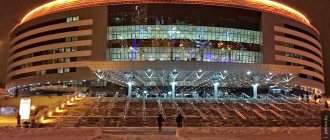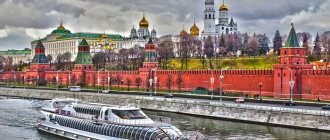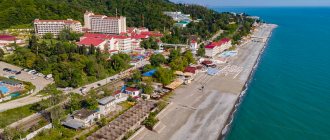Vitebsk
According to legend, the city off the banks of the Western Dvina and Vitba was founded in 947 by Princess Olga . Centuries later, it was destined to become a world treasury of talent: outstanding artists Marc Chagall , Kazimir Malevich , Osip Zadkine , Ivan Puni , philosophers Nikolai Lossky and Mikhail Bakhtin ... And today the city is the largest cultural center of Belarus, the capital of a unique arts festival " Slavic Marketplace" . Among the main attractions of Vitebsk are the ensemble of Town Hall Square, the Church of the Resurrection, the Governor's Palace, the Holy Assumption Cathedral and the famous Kirov Bridge over the Western Dvina.
The special pride of Vitebsk is the most extensive tram system , which is more than 110 years old.
House-Museum of Marc Chagall in Vitebsk
The most famous native of Vitebsk, Marc Chagall , is one of the brightest representatives of the world avant-garde of the 20th century. The master’s heritage includes paintings, illustrations for the poetry of Andre Breton, Blaise Cendrars, Guillaume Apollinaire , design of the ballets “Aleko” by Leonide Massine and “The Firebird” by George Balanchine, paintings of the Paris Opera Garnier , as well as sculpture, ceramics, graphics... All his life the artist maintained a reverent love for his native city: its roofs, churches, people are on every Chagall canvas. The Vitebsk House Museum presents one of the richest Chagall collections in the world - more than 300 original graphic works and reproductions of the most famous paintings.
Vitebsk, Pokrovskaya street, 11
11.00 – 18.30, weekends: from October 1 to March 1 – Monday, Tuesday; from March 1 to October 1 – Monday
In addition to the house-museum, there is an art center of Marc Chagall (Putna Street, 2), where exhibitions of the master’s graphic works and traditional Chagall readings , bringing together researchers of the life and work of the genius of the 20th century.
Other sights of Vitebsk
I regret that I didn’t have enough time to drop into the house-museum of one of the most famous avant-garde artists in the world, Marc Chagall (on the map). In my opinion, this is one of the must-visit places, but unfortunately I missed it.
Behind the scenes were such attractions as:
- The summer amphitheater is not far from the historical center of the city, and, by the way, is depicted on one of the Belarusian banknotes.
- City Hall - considered the hallmark of Vitebsk, in the photo it flashed behind the Church of the Resurrection
- Holy Spirit Monastery - a monastery at the foot of the Assumption Hill
- Castle Square
- Theater named after Yakuba Kolos
And they remained behind the scenes because the post is not rubber. Of course, I have something to tell you, but I shouldn’t bore you with a ton of photographs? Now I’ll insert the last one and that’s it.
Pigeons in a house, one of my favorite photos from Vitebsk
Museum-estate of Ilya Repin “Zdravnevo”
The Museum of the great Itinerant artist Ilya Repin is located in the vicinity of Vitebsk . In 1892, using the fee for one of his most famous paintings, “Cossacks writing a letter to the Turkish Sultan ,” sold to Alexander III, the master bought the Sofievka estate, returning its old name Zdravnevo . More than 40 paintings were created here (“Autumn Bouquet”, “Belarusian”, “Duel”, “Moonlit Night”, “In the Sun”), numerous drawings, studies and sketches... These, along with photographs, books and letters, can be seen in the museum restored manor. Among the most valuable exhibits are images of Christ and the Mother of God with Child , painted for the iconostasis of the Sloboda Church, near the walls of which the artist’s father is buried. In Zdravnevo, a linden alley planted by Repin himself has also been preserved.
The museum-estate often hosts creative meetings, exhibitions and plein airs of contemporary painters.
16 km north of Vitebsk towards the town. Ruba
Traveling around the Vitebsk region: the end of an exciting tour
The Vitebsk region is an excellent Belarusian region, simply created for travel. It will give you indelible impressions and emotions, once again convincing you of how beautiful Belarus is. Like and follow updates on the Blog. Travel with VETLIVA
!
TO TRAVEL IS TO LIVE!
Subscribe to our newsletter! Interesting travels around Belarus, city guides, advice on sanatoriums, gastro tours, news and promotions with the best prices for vacations.
Polotsk
The chronicled history of one of the oldest cities in Eastern Europe begins with its first mention in 862 in the Tale of Bygone Years. Polotsk was a large craft and trade center, through which one of the main routes of the great route “from the Varangians to the Greeks” passed. This is the “cradle” of the Belarusian state and culture, the capital of the first principality, the birthplace of the outstanding Slavic educators Euphrosyne of Polotsk , Francis Skaryna , Simeon of Polotsk . The most ancient city of Belarus carefully preserves its cultural heritage - majestic churches and Orthodox shrines , including the restored Cross of Euphrosyne of Polotsk .
According to scientists, the geographic center of Europe . A memorial sign has been installed here , and each guest can receive a certificate of their stay in this special place.
Vitebsk region
Five reasons to visit the Vitebsk region
1. Go to the largest raised bog in the country, eat cranberries at the festival and see thousands of cranes
The Yelnya bog in the Vitebsk region is nine thousand years old. A monument to the Ice Age, it has the status of the largest raised bog in Belarus and one of the largest in Europe. Its area extends over 200 thousand square kilometers. The water from most of the local lakes, of which there are more than a hundred, is drinkable. Yelnya is unofficially called the “bird house”, where over ninety species of birds live. It is here in the fall that the cranes make a month-long stopover as they fly to South Africa for the winter. The Yelnya swamp is capable of breaking the darkest swamp stereotypes. More than others, it is ready to receive tourists. Several years ago, a wooden deck was built one and a half kilometers deep into Yelnya, ending at a clean lake, where those who wish can swim. The Ozeravki ecological trail was opened here, equipped with information stands and observation platforms. People go to Yelnya to see the yellow-red-brown shades of a moss carpet, lilac heather, and on it - a scattering of blue, red and orange blueberries, cranberries, lingonberries, cloudberries and blueberries. You can get even more impressions if you walk on the fragile flooring in swamp shoes - special metal devices in which you should walk in small steps to better maintain your balance.
The real decoration of the Yelnya swamp is Lake Kurganistoe.
At the end of September, on the outskirts of Yelnya, the ecological festival “Cranes and Cranes of the Mersk Region” takes place. It is in the high bog of Yelnya that the largest supply of these unusually useful berries is stored. At the festival you can learn how, where and when to pick cranberries, what to do with the berries, how to store them, try them in different roles, and also buy cranberries for the winter. Cranberries ripen in September-October and remain for the winter, so they can be collected even after the snow melts.
In Belarus, which occupies one of the first places in the volume of collection of sour red berries, cranberries are highly revered. The berries bloom for 18 days in May with light purple and pink flowers on a slender stalk. Their appearance reminded Belarusians of the neck and head of a crane, which is why the berries began to be called “cranes.” The berry is revered for its beneficial properties - it is rich in vitamins PP, B, C, phylloquinone, potassium and tannins. Fruit drinks, jelly, juices, kvass, jams are made from the berries, and the leaves are added to tea. On holidays, housewives put a strong “crane” on the table, and as a gift for foreign guests they bring cranberries in sugar. Birds also take part in the cranberry festival, after which the berries are named. During the autumn migration, up to 400 thousand cranes can be seen on Yelnya. A regular participant in the festival, the organization “Akhova Bird of Fatherland” conducts crane excursions led by an experienced ornithologist. Having driven just a few kilometers, you can see the beauties listed in the Red Book and get a good look at them through the lens of a telescope.
2. Relax on the Braslav Lakes and stay in the Maldives
Braslav began to actively use its tourism opportunities at the beginning of the twentieth century. The healing pine air, lakes, and hilly landscape have turned the town and its surroundings into a full-fledged resort. Having recovered from the destruction of war, the city continues to rely on tourism and recreation. Braslav lakes are well known to tourists, and in the summer a stream of cars rushes towards the town. Around Braslav there is one of the largest lake groups in Belarus, which includes more than fifty lakes. Tourists call the central part of the group Braslav - water hiking routes pass through it. The most famous of them are Drivyaty, Tsno, Nespish, Nedrovo, Potsekh, Voiso, Boloyso, Strusto, Snudy, North Volos and South Volos, connected by the Druika River and channels. Less known, but no less attractive, is the Obsternovskaya group of 13 lakes on the border of the Braslav and Miory regions. Uklya, Obsterno, Nobisto, Ikazn are the most picturesque of them.
Slobodkovskaya ozovaya ridge
In the mid-90s, the Braslav Lakes National Park was created in the Braslav region, designed to preserve the natural resources of the region. Recreation on the local lakes is possible in designated areas. A complete list of recreation centers, as well as tourist sites, is publicly available on the official website of the national park. Some of them have very fancy names. So, on Lake Uklya the sites are called Bali, Caribbean, Miami, Maldives, Fiji, Tahiti. Lake Strusto has its own Tunisia and Türkiye. Parking lots are available on lakes Albenovskoye, Dolgoye, Bolto, Medvedno, Elno, Obabye. If relaxing in a tent is not for you, then every year more and more rural estates and places for comfortable relaxation appear in the Braslav region.
3. Find the addresses of Marc Chagall in Vitebsk
Vitebsk is the birthplace of Marc Chagall. The city attracts Chagall scholars; thousands of tourists come here to find the addresses of the world-famous artist.
Address No. 1: st. Pokrovskaya, 11.
The Marc Chagall House Museum, opened in 1997, is located here. It is believed that after a big fire, the family of the future artist moved here from a poor quarter on the left bank of the Dvina called Peskovatiki. The city began with this street for Chagall: here he played dominoes, feathers and towns, in his parents’ house he exhibited his drawings for the first time, and in the house next door, where he rented a studio, already a recognized artist in Europe, he created the “Vitebsk Series”, works of which are now in private collections in St. Petersburg, Paris, and in museums in New York and Moscow. City architects have more than once discussed the project of creating a Chagalovsky quarter on Pokrovskaya Street - with a hotel, cafe, post office and souvenir shops. Now the street, lined with factory buildings, has an industrial appearance. On July 7, Chagall's birthday is celebrated on the street and in the courtyard of the museum. At the evening “At Mark and Bella’s” there is music, poetry, songs, dances and theatrical performances.
Address No. 2: Malaya and Bolshaya Ilyinskaya streets.
Now the street bears the name of Revolutionary, and once - in honor of the unpreserved St. Elias Church. The stone Lubovitch Synagogue appeared on this street at the beginning of the 20th century. At that time, there were more than 50 synagogues and houses of worship in Vitebsk. In today's Vitebsk, the synagogue on Revolutsionnaya is the only one whose ruins have been preserved. Perhaps Chagall’s father went to this synagogue, perhaps Chagall himself. Going to the synagogue became the artist’s most vivid childhood memories. Later he would paint many works with Vitebsk synagogues and their interiors, among them “Synagogue”, “Studying the Bible”.
Address No. 3: corner of Bolshaya Mogilevskaya and Rozhdestvensky Lane.
Now the building of the former four-year school, where Chagall entered in 1900, stands on Lenin Street, 24/15 and belongs to the city center for additional education of children and youth. Chagall studied poorly and was left for the second year in the third grade. But in geometry and drawing lessons he was praised and held up as an example.
Address No. 4: Bukharinskaya st., 10.
In 1918, holding the rank of Commissioner for Arts of the Vitebsk Province, Chagall opened the People's Art School, where he invited Yudel Pan, Vera Ermolaeva, El Lisitsky, and Kazimir Malevich as teachers. The school building has been preserved. The VNKhU museum operates in an architectural monument of the 19th century; the street was renamed in honor of Marc Chagall.
Address No. 5: st. Putna, 2.
The two-story brick building on the banks of the Dvina was a private house, a communal apartment, and since 1990 it has housed the Marc Chagall Art Center with original works by the artist. These are 300 graphic works by Chagall, including illustrations for Gogol’s poem “Dead Souls”. Most of the works are exhibited in the summer, during the high tourist season. The Art Center houses a rich library with publications dedicated to the life and work of Chagall and art history.
This is from the surviving addresses. To learn more about Chagall's life and work in Vitebsk, it is worth signing up for one of the thematic city excursions. And also attend performances dedicated to the artist at the Yakub Kolas Theater and the Lyalka Puppet Theater.
4. Visit the city of museums, buy a guide to Polotsk at the beginning of the last century and talk to the head of Gabriel Gruber
Polotsk is called the city of museums in the Vitebsk region. Not only does the city itself - with its streets, houses, monuments, temples - breathe history, but the concentration of museum institutions in it is quite high. The city has created the National Polotsk Historical and Cultural Museum-Reserve, which includes 11 museums. Separate museum exhibitions are located in architectural monuments. Thus, the museum of the history of architecture of the St. Sophia Cathedral is located right in the shrine, the art gallery is in one of the buildings of the Polotsk Jesuit College, the Museum of Traditional Hand Weaving of Poozerie and the Children's Museum occupy buildings of the late 19th - early 20th centuries, under the Museum of Belarusian Printing and the Museum-Library of Simeon of Polotsk The premises of the former Fraternal School of the Polotsk Epiphany Monastery have been adapted, the local history museum has occupied the building of the former Lutheran Church, and the only one-street museum in Belarus, “Walk along Nizhne-Pokrovskaya,” is located in the house of Peter I. The natural-ecological museum with an observation deck occupies the building of a water tower. By booking a separate tour of the building of the former Jesuit college, you can meet and talk with the mechanical head of Gabriel Gruber. Having taught technical sciences in Polotsk at the end of the 18th century, the engineer can answer in Russian, Belarusian, English and Latin. After socializing, you should try hot chocolate according to Gruber’s recipe with spices and ginger and listen to the mechanical piano play. And after walking through the exhibition of one street, you can buy a guide to Polotsk in 1910, published for the celebrations of St. Euphrosyne, when the saint’s relics were transported from Kyiv to Polotsk.
The museum collections number about one hundred thousand museum objects, distributed across 35 collections. And the exhibitions are supplemented with QR codes, audio guides in Russian, Belarusian and English. Help information is always available at information kiosks. The museum's poster is full of events - quests, theatrical excursions, thematic exhibitions. It’s easier to walk around the reserve with a single ticket that opens the doors to all 11 museums.
Monument to the heroes of the war of 1812 in Polotsk
There are other places worth visiting in Polotsk. One of them is a private museum of medieval chivalry. First mentioned in 862 in the Tale of Bygone Years, Polotsk on the banks of the Western Dvina looks like a museum itself. Being one of the oldest Belarusian cities, it tops the list of places to visit for those interested in history. Here you can see monuments to Francis Skaryna, Simeon of Polotsk, Saint Euphrosyne, Prince Vseslav the Magician and even the letter of the Belarusian alphabet - Ў.
When going to Polotsk, take with you books by Vladimir Orlov and Sergei Tarasov. With them, a walk around the city will be more meaningful and interesting.
5. Listen to a “live orchestra” in the Berezinsky Nature Reserve
The Berezinsky Biosphere Reserve, part of the global network of UNESCO biosphere reserves, is the only one in Belarus. With a total area of 85.2 hectares, it is located in the northern part of the country on the border of the Vitebsk and Minsk regions. The reserve alternates between different types of forests, meadows and swamps - the vast swamp areas covered with black alder are especially valuable. The Berezina, as well as large and small rivers and lakes, cut through them with a ribbon of water. Rare species of plants and animals are protected here, some of which are listed in the Red Book. Beaver, otter, badger, osprey, black stork, gray crane, golden eagle, white-tailed eagle and many others live here. In one territory of the Berezinsky Nature Reserve, the “big European five” large mammals live in the wild - elk, bison, wolf, lynx and brown bear. Moreover, the latter constitute a third of the Belarusian population. The reserve has developed hiking, cycling, horseback riding, skiing, and combined routes, as well as exciting trips along the Berezina water system, which is considered part of the path “from the Varangians to the Greeks.”
Seasonal tours are also popular. During the spring Live Band program, tourists flock to the forest to hear the birds sing. Let us remind you that you can only be on the territory of the reserve if accompanied by an employee.
The administrative center of the Berezinsky Nature Reserve is located in the village of Domzheritsy. There is a nature museum with three halls displaying stuffed 170 species of birds and 20 mammals that live in the reserve. The forest zoo is open to the public. On 12 hectares on the edge of a pine forest live elk, bison, bear, lynx, wolf, deer, fallow deer, wild boar, roe deer, fox, raccoon dog. And at the center of mythological tourism is the fairy-tale character Bolotnik. You can take a break from your impressions in guest houses, and satisfy your hunger in the Lesnoy Tavern cafe and restaurants in hotel complexes.
Saint Sophia Cathedral
The Cathedral of Sophia of the Wisdom of God , one of the earliest Orthodox churches in Europe and the first stone one in Belarus, is included in the tentative UNESCO World Heritage List . Erected in 1044 - 1066 by order of Prince Vseslav the Magician , it personified the independent and powerful Principality of Polotsk . The cathedral followed its "elder sisters" in Kiev and Novgorod, built on the model of the cathedral in Constantinople , and became Hagia Sophia in the world In the middle of the 18th century it was significantly rebuilt in the original Vilna Baroque .
Nowadays, here you can see ancient frescoes and a copy of the famous work of Leonardo da Vinci “The Last Supper” , listen to masterpieces of Belarusian and foreign organ music , and visit the museum of the history of the cathedral’s architecture.
Polotsk, st. Zamkovaya, 1
Miory
The place on the shore of the picturesque Lake Merskoe has been known since 1514 as the estate Mereya , which belonged to the governor Ivan Sapega, and then to the famous family of princes Svyatopolk-Mirsky . Modern Miory is a cozy city with preserved architecture of the 18th – 19th centuries, a beautiful embankment with a length of about 500 meters. of the Assumption of the Virgin Mary (Assumption) built in 1907 , where rare icons and sculptures of the 19th century have been preserved. The compositions installed in our time are also interesting: the only monument to an unborn child (1991), a sculpture of the Mother of God with the baby Jesus (1998), a monument to Pope John Paul II .
238 km from Minsk and 190 km from Vitebsk
In the Miory district is located the smallest city of Belarus - Disna , which received the Magdeburg Law and its coat of arms “Ladju” back in 1569. Here is the middle of the famous Western Dvina River, into which the river of the same name as the town of Disna flows.
Republican landscape reserve "Yelnya"
One of the largest massifs of ancient raised bogs and glacial lakes is located in the Belarusian Poozerie region . A natural monument with unique flora and fauna has international conservation status: an area important for birds (since 1981), a Ramsar site (2002), a key botanical area (2005). the Yelnya swamp , which has existed for more than 9 thousand years , the area of which is about 20 thousand hectares. In autumn, these places turn into a real “bird paradise”: more than 4 thousand gray cranes and 10 thousand geese stop at the swamp. largest crops of cranberries (white cranes) are also harvested here
You can watch flocks of birds, walk along an eco-trail and feel the quagmire under your feet, and also try unusual dishes and drinks made from cranberries at the annual ecological festival “Cranes and Cranes of the Miyorsk Region” .
Miory district
Braslav
The city of Braslav , known in written sources since 1065 , is located in the very heart of the lake region of Belarus : only within a radius of 30 km there are three dozen lakes, and the city itself is surrounded on all sides by mirror-like surfaces of water. The largest of the surrounding “pearls” is Lake Drivyaty , the fifth largest in Belarus. You can see this natural beauty from the very center of Braslav, where the ancient settlement of Castle Hill . The city, whose coat of arms depicts the Christian symbol - the eye of God's care, is also famous for its spiritual shrines. Among them is the beautiful Church of the Nativity of the Blessed Virgin Mary (late 19th century), where the miraculous Braslav Icon of the Mother of God - the Queen of the Lakes, intercessor and patroness of the region.
240 km from Vitebsk
A new landmark of the city, noticeable from afar, was the large letters of the name “BRASLA” and the image of the coat of arms on the slope near the shore of Lake Drivyaty. The inscription, illuminated at night, stretches for 15 meters.
Braslav is also interesting for its events: every year the festival of medieval culture “Sword of Bryachislav” , the international festival of traditional culture “Braslav Lightnings” , the music and sports festival and sailing regatta VIVA BRASLAV , the music festival “Living Sky of Braslav” are held here .
Events
The richest festival poster is in the administrative center of the region. The international arts festival “Slavic Bazaar in Vitebsk” has been participating in event tourism for almost three decades. For many travelers, the art forum becomes a reason to visit Vitebsk. In recent years, the festival has increasingly acquired a street format, and in addition to the international competition, solo concerts have new forms in the program - the festival “On the Seven Winds”, “Puppet Quarter”, “Musical evenings at the Philharmonic”, sports competitions, processions and parades. In November, the IFMC Festival of Contemporary Choreography has been taking place in Vitebsk for three decades. Dance campaigns, famous choreographers and world premieres in the multifaceted direction of contemporary dance perform on the Vitebsk stage over several festival days. Along with traditional events like the Sollertinsky Festival, many new events appear, each of which is worthy of a visit. Among them are the young festival “Cardboard”, poetry readings “Baradulinki”, “Photakrok” named after Sigismund Yurkovsky. The organ music festival “Zvany Safii” takes place in the St. Sophia Cathedral in Polotsk. This is a landmark event in the music world. Since the appearance of an organ in the temple in 1985, custom-built by the Czech company Rieger Kloss, about 300 concerts are given in the concert hall every year. And in the spring, connoisseurs of the sound of keyboard and wind instruments come to St. Sophia Cathedral to participate in the festival of ancient and modern chamber music. The celebration of the Day of the Mother of God of Braslav, Lady of the Lakes, gathers thousands of believers in Braslav. The main celebrations take place at the church - on a stage in the form of a ship sailing on the lakes. The Viva Braslav youth festival on the banks of the Drivya has in a short time become one of the most popular open-air music events in the country. The Sprava festival in Bila Tserkva has a more intimate format. The event transformed the village, making it an atmospheric place. The ruins of an old church on the peninsula became the main festival site. The mythology festival “Visiting Lepel Tsmok” is suitable for mythology lovers. The Lepel Tsmok, which lives in the local lake, becomes the calling card of the region. For lovers of historical reconstruction - festivals of medieval culture "Rubon" in Polotsk and "Sword of Brachyslav" on Castle Hill in Braslav. The gastronomic direction is supported by the cranberry festival “Cranes and Cranes of the Mersk Region” and the Cherry Festival in Glubokoye. The holiday takes place in July. Participants compete for the title of best cherry pit shooter and place bets on cherry snail races. A few years ago, a cherry orchard of one and a half thousand trees was planted near Glubokoye - an opportunity to look at the Belarusian cherry “hanami”. Another gastrofest is “Blueberry Festival” in Polotsk. It starts at six in the morning, when participants armed with baskets and buckets go into the forest to pick blueberries. The competition lasts several hours, and the picker with the most berries wins. The celebration continues in the city. And the main treat there is a multi-meter blueberry pie.
Braslav Lakes National Park
The ancient glacier left more than 10 types of relief in the Braslav Lake District , which became one of the main features of the region. Large and small lakes with bizarre shores, winding rivers , numerous islands (on some in ancient times there were fortresses and a monastery), glacial hills (eskes and kamas) - all this created the conditions for rich flora and fauna. the Braslav Lakes National Park, founded in 1995, with an area of about 70 thousand hectares, more than 1,900 plant species grow and 312 species of vertebrate animals live. Here you can see a huge number of birds, including rare birds: great bittern, black stork, white crane...
On the territory of the Braslav Lakes, fascinating eco-trails have been laid out for tourists and a safari park is being created, tours are held for hunters and fishermen, and a pleasure boat runs along Drivyaty in the summer season. Find out more about the park here .
The administrative center of the national park is located in the city of Braslav
Souvenirs
Linen products are brought from the Vitebsk region as souvenirs. The Orsha Flax Mill operates under the Belarusian Flax brand, producing clothing, bed linen, and accessories. Tourists often visit the branded stores of shoe companies Belwest and Marko. Edible souvenirs are brought as gifts - cheeses from Braslav, Postavy, Polotsk, Verhnedvinsk, Lepel. Vitebsk’s “MyaskoVit”, “Vitkon Product”, “Ganna”, “Grandmother’s Delicacies” of the Glubokoye Meat Processing Plant, and “Mara Gurmana” from Gorodok are famous for their meat products. Sweet brands include Vitba and Karavay Pridvinya. Condensed milk and sugared cranberries are brought from Glubokoye. produces cranberries in powdered sugar, in chocolate glaze with coconut and peanuts, sets of sweets, marmalade, jam, syrups from wild and garden cranberries. In every historical center there are souvenirs with emblems of cities and city symbols on stationery, clothing, and accessories. In bookstores you can buy photo albums and postcards with views of your favorite places. And for some, memorable trophies after a successful hunt will be a souvenir from the Vitebsk region.
Trinity Church in the village of Vidzy
The Church of the Nativity of the Virgin Mary (Trinity) in the urban village of Vidzy is the second largest Catholic church in Belarus, second only to the shrine in Budslav . It is also one of the highest: the spiers of the temple reach 59 meters, which is slightly less than the famous “record holder” church in Gervyaty (61 m). The first Catholic parish was founded in Vidzy back in 1481 by Bernardine monks. was seriously damaged during the First World War In memory of those tragic events, artillery shells were built into its walls.
In 2014, the church in Vidzy celebrated its centennial anniversary , and still retains its grace: soaring towers and pointed arches, windows with openwork frames and colored stained glass...
Braslav district, town Vidzy, 40 km from Braslav and 260 km from Vitebsk
Good luck!
Grandland X has very decent sound insulation. The car is good to drive, holds the road confidently and has normal dynamics for urban driving. The automatic transmission changes gears quickly and smoothly. The energy consumption of the suspension is average. Despite its frankly rather large weight, small engine capacity (turbocharged petrol 1.6 liters, 150 hp) and the absence of an all-wheel drive version, the new crossover from Opel turned out to be quite passable, performed well on snowy roads, and coped with small snowdrifts , did not go into drifts. But, to be honest, the car lacked dynamics on the highway, so the Grandland X left the impression of being more of an urban crossover rather than a full-fledged SUV (but, in fact, it doesn’t pretend to be that).
The Grandland X headlights deserve special attention. We have never seen better and more voluminous light from these headlights in cars of this class. Projection-type LED headlights with Full LED (adaptive) technology are installed here; in tandem with halogen fog lights, they create an excellent viewing angle. With such a light as in the Opel Grandland X, driving in the dark will definitely cause less discomfort for the driver and create an additional feeling of safety for passengers.
Conclusion: The Opel Grandland X is an excellent, reliable city crossover, a German car with French origins. Practical, laconic, modern, comfortable, which is suitable for both women and men, and will easily become a family car. Innovation, comfort, safety - perhaps these are the compelling arguments in favor of the new Grandland X.
Postavy
The history of the heyday of Postavy (1409) is associated with the famous Tyzengauz dynasty , who owned the town since the 18th century. An influential figure of the Grand Duchy of Lithuania, industrialist and philanthropist Antony Tizengauz Giuseppe de Sacco to Postavy to organize a new stone building, which has partially survived to this day. At the Tizengauz factories in Postavy they made paper with watermarks for state needs, sails for the Grand Duchy of Lithuania fleet, and gold-embroidered belts that were not inferior in quality to those from Slutsk . Later, another representative of the genus, the enthusiastic ornithologist Konstantin Tizengauz , turned Postavy into a center of science. At various times, the Tizengauze Palace housed a ballet school, a rich ornithological museum - the base of the Faculty of Biology of Vilnius University, and an art gallery.
Today, the Tizengauze Palace (in 1760) houses a hospital, and in the basements there is a historical exhibition dedicated to the glorious dynasty and the history of the First World War . Other attractions in Postavy include the Church of St. Anthony of Padua , St. Nicholas Church (1894), and a monument to Konstantin Tyzenhaus .
Where to visit?
In the year of the 140th anniversary of the birth of Fyodor Makhnov, a new holiday appeared on the Vitebsk festival poster - the Volaty Prydzvinnya festival in Maly Lettsy. It is expected that the event dedicated to the tallest man will become an annual event, and his figure will become a recognizable brand of the region.
The Repin Museum-Estate in Zdravnevo has been the venue for the scientific and practical conference “Vitebsk Antiquities” for several years. Musical evenings and ethnographic festivals are also held here.
Church of St. John the Baptist in the village of Kamai
In the village of Kamai, Postavy district, stands an unusual church - one of three Belarusian fortified temples included in the preliminary UNESCO World Heritage List . At the same time, it differs significantly from two other shrines - Orthodox churches in Synkovichi and Murovanka . The Kamai Church, built as a fortress, was indeed a place of defense during the war with the Swedes, as evidenced by traces of cannonballs in the walls. In addition, the temple, built in 1603-1606, is one of the few in Belarus that has never been closed . Its central altar contains a miraculous icon of the Mother of God with a child (17th century).
Postavy district
What should I bring?
One of Nikolai Nikiforovsky’s books can serve as a memory of trips around the Vitebsk region. For example, “Unclean Ones” is a collection of common folk tales in Vitebsk Belarus about evil spirits, or “Common folk signs and beliefs” collected in the Vitebsk region. Superstitious rituals and customs, legendary stories about persons and places.” An exotic souvenir would be a piece of dolomite from the bottom of a prehistoric sea or a photograph of your own foot next to the boot of Fyodor Makhnov, in whose galoshes they say children slid down the mountain like on a sled. The taste of the delicacy brought from the Ganny brand store and fresh Rudakovsky cucumbers can also evoke nostalgia and become a reason for another trip to the outskirts of Vitebsk.
Glubokoe
The city of Glubokoe , with more than 600 years of history, is called the “cherry capital” of Belarus. The first gardens appeared here thanks to the breeder Boleslav Lapyr, who brought seedlings from different countries and developed new winter-hardy varieties. Recently, residents revived the cherry orchard , planting 1,414 trees in honor of the city’s birthdate, and founded a distinctive cherry festival . the Trinity Church and the Cathedral of the Nativity of the Blessed Virgin Mary (a former Carmelite church built in 1639-1654), standing opposite the holy Mount Athos . Interestingly, there are five lakes on the territory of Glubokoye.
The list of popular attractions of the city includes a bronze sculpture of a cherry tree , a monument to Baron Munchausen , a square of famous natives of Glubotchina , including the artist Yazep Drozdovich , the founder of the Belarusian theater Ignat Buinitsky , aircraft designer Pavel Sukhoi , writer Vaclav Lastovsky , the father of modern Hebrew Eliezer Ben-Yehuda .
160 km north of Minsk
Church of St. Anne in the village of Mosar
Prosperity for Mosar, known since 1514, was brought by the noble family of Brzhestowski. By order of the married couple Robert and Anna Brzhestowski, palace and the Church of St. Anne were built on the estate , which, unlike the count’s residence, has survived to this day. by Father Jozas Bulka, who came to serve in 1989 . He turned the swampy surroundings into a beautiful arboretum with religious sculptures, fountains, and flower beds. Among the attractions of the “Belarusian Versailles”, as Mosar is called, is a copy of the famous
from St. Peter's Basilica in the Vatican, the tallest Catholic cross in Belarus (23 m), a 5-meter statue of Christ ...
In the former belfry, Father Bulka founded the first and only anti-alcohol museum . And in the ancient barn of Mosar there is an ethnographic exhibition .
Glubokoe district, Mosar village
What to see
Approximate date of construction of the Polotsk St. Sophia Cathedral
Historians define it between 1044 and 1060. This was the first stone temple on the territory of Belarus. Built as a symbol of the power of princely power, the cathedral on the right bank of the Western Dvina looked majestic and solemn. Today, all that remains of the 11th century temple is the ancient foundation, parts of the apse, pillars and walls. You can see all this, as well as fragments of masonry and fresco paintings of the 11th century, and hear numerous stories about Sophia in the museum operating at the temple. Well, if you listen to the organ, then in the concert hall of the St. Sophia Cathedral, which has the status of one of the best in Europe.
One of the oldest Orthodox monasteries in the Belarusian lands - founded by St. Euphrosyne and opened in 1125, the Spaso-Euphrosyne Monastery in Polotsk
. The architectural ensemble of the monastery is created by the Church of the Savior Euphrosyne, the Church of the Exaltation of the Cross, a “warm” church, a two-story residential building, a gate with a belfry, combined with a residential monastery building, and the foundations of what existed in the 12th–17th centuries. temple-tomb. On the walls and columns of the church, images of saints made by masters of the 12th century have been preserved. At the end of the 1990s, the gilded cross donated to it by Euphrosyne returned to the temple: an exact copy of the relic created by Lazar Bogsha was made by Nikolai Kuzmich, a jeweler-enamel maker from Brest. In 1910, the relics of Saint Euphrosyne were transferred to Polotsk from Kyiv, where they had been preserved since 1187. Pilgrims from Belarus and European countries come to venerate the relics. There is a tour desk at the monastery; guests are provided with free hotel rooms and treated to meals.
The Church of St. John the Baptist in the village of Kamai is over 400 years old. Built in 1603-1606, it is considered one of the oldest Catholic churches in Belarus. For four hundred years, the shrine was never closed, even during Soviet times. It is classified as one of the rarest types of temples - defensive. The silhouette of the church is created by towers 16 meters high and 5 meters in diameter. During the Northern War, the temple was fired upon by the Swedes - cannonballs from those times were mounted in two-meter walls. Inside, the vaults are decorated using the grisaille technique, and the interior is decorated with four wooden altars. The church houses more than a hundred items of historical value. Among them are a 17th-century icon of the Mother of God, wooden statues of Peter and Paul, the oldest organ in Belarus, installed above the entrance to the choir in honor of the 300th anniversary of the temple. The composer and conductor Branislav Rutkovsky began to play on it. Next to the temple is an ancient stone cross of the 15th-16th centuries, 2.5 meters high, carved from a granite boulder with a triangular niche for a crucifix.
Holy Assumption Church in Sarya
the mid-19th century is called the most expressive neo-Gothic temple in Belarus. It was built as a Catholic shrine, but has now been transferred to the Orthodox parish. The author of the project was the Prussian architect Gustav Schacht, who took up the work at the request of the Saryan landowner Ignatius Lopatinsky. Having buried his young and beautiful wife, Ignatius wanted to see her beauty in the temple and express the depth of his feelings in architecture. After the war, the temple, alas, was used as a warehouse and entertainment venue.
The Trinity Church in Vidzy was also built in the neo-Gothic style. It was built at the beginning of the twentieth century according to the design of the architect Vaclav Mikhniewicz, the author of about 30 churches in Lithuania and Belarus. It was heavily damaged during the wars of the last century. Military shells from the First World War have been walled up in the walls. In the post-war period, the church had a warehouse, a granary, and a gym. Since 1989, the shrine has been in operation again. The Vidzovsky Church is called one of the highest in Belarus - the height of its spiers is 59 meters. You can climb the towers of the church along a narrow staircase and see a panorama of the town, Disna, and neighboring Lithuania.
The village of Mosar in the Glubokoe district of the Vitebsk region is definitely worth a visit. The spiritual center of the village is the Church of St. Anne, built in 1792. The flourishing of the village is associated with priest Joseph Bulka. Now the tourist and pilgrimage complex consists of a church, a small copy of the Ostrobramskaya chapel, an ancient gateway and fence of the 19th century, a bell tower, a park, a monument to John Paul II, a sculpture of Our Lady mourning Jesus - a copy of Michelangelo’s sculpture, a club with billiards, an ostrich farm, a sports ground, an alley of sobriety, a prayer alley with chapels, many gazebos for relaxation, and a spring with holy water. Father Bulka was the initiator of the creation in the 90s of the twentieth century of the only anti-alcohol museum in Belarus, which became a symbol of the fight against drunkenness. The museum is located in a small wooden building near the Church of St. Anne. Villagers' moonshine stills, bottles of strong drinks, and drinking utensils became exhibits. Over time, the exhibition was replenished with propaganda posters and receipts from village residents that they refused to drink. In matters of sobriety, Father Bulka was very principled: he refused to serve in a house where there was alcohol, and forbade parishioners to enter the church while drunk. He not only banned, but also offered an alternative to the bad habit - a free visit to the parish house, where you can relax, watch TV, drink tea, play billiards or tennis.
It is possible to devote a separate excursion to the shrines of Vitebsk - the Assumption Church, the Church of the Resurrection, and the Church of St. Barbara rise above the city. The Church of the Annunciation is worth visiting first of all because of its advanced age. This monument of ancient Polotsk architecture of the 12th century stands on the left bank of the Western Dvina. The church was probably built by Byzantine craftsmen, alternating dolomite hewn blocks with 2-3 rows of plinth. In 1961, the temple was partially demolished - they wanted to build a turning tram circle in its place. It was restored in the 90s on old foundations while preserving the masonry of the ancient walls, which survived up to a height of 5 meters.
This mysterious place near Polotsk is called the “Belarusian Stonehenge”. The stones here are not as large as those in the famous Wiltshire complex, and are in a different order - those that rise above the ground form the Cyrillic letter “P”. Group of stones on Lake Yanovo
arouses interest among local historians, historians, archaeologists and even ufologists. The place is undoubtedly ancient and energetically charged. Perhaps the stars were observed here, using the complex as an archaeastronomical observatory, Kupala was celebrated here and mysterious rituals were celebrated. Now the monument has been given the status of historical and cultural value, which is often visited by tourists.
The Vitebsk region is deservedly called the lake region. There are a large number of them and each one is worthy of a visit, but let’s focus on the largest, the most mysterious and the one where Tsmok probably lives.
Lake Osveya with its islands is the second largest in Belarus. Doux Island is the largest in Belarus with an area of 5 sq. km. This ancient Finno-Ugric name translates as “lake”. On modern maps, the country's largest island is marked with the name Ostrov. This was the name of the island village, which consisted of more than fifty households with a store, a farm, its own club and a diesel substation. It was possible to get to the island by boat, on foot or by sleigh on the ice, and after the war - by ferry. It became depopulated in 1970. The Island is now recognized as a sanctuary for wolves and moose, and a good place for bird watching. Perhaps there will be special places for photo hunting on the island, from where you can catch a bald eagle or a white heron through your lens. The second island of Lake Osveya is floating. Not fixed to the bottom, it slowly moves along the surface of the lake, whose area is 54 sq. km., with an average speed of 1-1.5 kilometers per hour, depending on the wind. The structure of the island, which locals nicknamed the Master and also the ghost island, resembles a nest. Instead of soil, intertwined algae, roots and branches. You can walk on them, but it is dangerous. Most likely - in winter, when Osveya is covered with ice. Vegetation on the island includes flexible trees and shrubs favored by birds. Every year it increases in size, because during the swim it collects everything in its path and, together with other, but smaller floating islands, contributes to swamping of the lake.
The third largest lake in Belarus, Nescherdo in the Rossony region is called one of the most mysterious and beautiful lakes in the Vitebsk region. Not far from the lake, in the village of Muragi, with windows facing the lake, there was a house where Yan Barshchevsky, the author of the famous collection “Nobles of Zavalnya, Albo Belarus in Fantastic History”, was born. The writer loved to walk around the neighborhood and walked around Nescherdo more than once. By the way, the lake has the longest coastline in the country, which is over 50 km. They say that if you walk along the shore of Nescherdo at sunset or dawn, you can hear the ringing of a wooden church that stood on a mountain in the middle of the lake. Barshchevsky wrote about this in the legend about the Volot to the Prince. Before heading to the land of fantastic stories, you can go to a play for adults at the Vitebsk theater “Lyalka” called “The Lost Soul, or Pakaranne of the Sinner,” staged based on the works of Jan Barshchevsky.
There are at least several dozen lakes in Belarus where the tsmok, or dragon, can live. One of them is located in Lepelshchyna. Tsmok, who lives in the lake on which Lepel stands, has not been seen for a long time, but local residents are convinced that at certain times it is still possible to see him. They say that fishermen used to often disappear on Lake Lepel, and after a while their boats, bitten in half, were found near the shore. The fishermen themselves were probably eaten by angry tsmoki, dissatisfied that fish were being stolen from their lake. A few years ago, a monument to the local tsmok was erected on the lake embankment, which was described in detail by Vladimir Korotkevich in the narrative “Christ Sprang in Garodnya”. Probably, the Lepel tsmok can become one of the mysterious symbols of the region, in whose vicinity there are several mysterious lakes. For example, Dragon Lake, where theoretically it is possible to build an entire Tsmoka residence. Or the Holy Place, at the bottom of which there is a church - in calm, sunny weather, at great depths, the crown of the temple is visible and the ringing of a bell can be heard.
Lepel
Historians still have not come to an agreement on where the name Lepel : the Belarusian words “lepei” (best) or “lyapits” (local potters were famous for their art), the Old Baltic “lepel” meaning “yellow water lilies” (on the reservoirs of the region they really a lot) or linden . The ancient city was founded in the 17th century on the shores of Lake Lepelskoye thanks to the Chancellor of the Grand Duchy of Lithuania Lev Sapieha . The monument to the great political figure was erected opposite the Church of St. Casimir . In 1602, this Catholic parish and temple was founded by Sapega, and in 1857 - 1876. a new building was built. Other attractions of Lepel the wooden church of St. Paraskeva Pyatnitsa, a chapel built in 1900, a synagogue building, and an ancient stone house.
In the central park on the shore of Lake Lepel there is a bronze sculpture of Tsmok , an amazing character in Belarusian mythology, the lord of lakes and swamps. By the way, Lepel became the first city in Belarus to become a member of the European Association of Folklore Groups.
155 km from Minsk and 110 km from Vitebsk
Celebrities
A native of the village of Vymno, Vitebsk region, was the Belarusian ethnographer, folklorist and local historian Nikolai Nikiforovsky. He collected ethnographic material, being more interested in the spiritual and material culture of the inhabitants of the Vitebsk province. In memory of his teaching activity, a memorial plaque was installed on one of the historical buildings on Tolstoy Street in Vitebsk. The village of Zazyby, Vitebsk region, became the small homeland of Mikhas Lynkov, the author of “Mikolka the Steam Locomotive” and the epic novel “Days of Ages.” In the village of Punishche, now in the Vitebsk region, the organizer of the partisan movement and hero of the Soviet Union, Minai Filippovich Shmyrev, was born. A memorial obelisk has been erected in his homeland, and a memorial museum is open to the public in Vitebsk. In Surazh, Vitebsk region, there is a monument to the children of Shmyrev, who were shot by the Nazis.
Many people know the name of Alexei Sapunov - a Belarusian historian, local historian, researcher of the Vitebsk region. He spent a lot of time at the Kakhovka estate on the banks of the Luzhesnyanka River. Alas, the estate no longer exists. Not far from the village of Sokolniki, only a memorial sign has been preserved. The surrounding area, however, has not lost its picturesqueness, and a walk through Sapunovo’s places can turn into an exciting adventure. But the “Miloye” estate in the village of Mazolovo, built at the turn of the 18th and 19th centuries by Ignat Mankovsky and named by the owner for the beauty of the local nature, has been preserved. Mankovsky served as governor, and then as vice-governor of the Vitebsk province, was known as an innovator in the field of economic management, and was versed in natural sciences and architecture. Wrote, and was named as the alleged author of "The Aeneid to Beverage."
Berezinsky Biosphere Reserve
The oldest protected area in Belarus is the Berezinsky Biosphere Reserve , founded in 1925. Unique ecosystems attract thousands of tourists here. In 1979, the reserve entered the UNESCO World Network of Biosphere Reserves , since 2005 - included in the International Ecological Network, in 2010 - in the Ramsar List of Wetlands... The protected area occupies over 80 thousand hectares and includes various types of forests and swamps , floodplain meadows, lakes and rivers. More than 2 thousand species of plants grow here (78 from the Red Book of Belarus ), dozens of species of mammals and hundreds of birds live. The Berezinsky Nature Reserve is the only place in Belarus and Europe as a whole where you can see all representatives of the “European five” - bison, bear, lynx, wolf and elk.
A unique project for Belarus is being implemented in the reserve: floating log houses with reed roofs, mounted on pontoons, will appear on Lake Plavno. The interior decor will be made of eco-friendly materials, and the motor drive will allow tourists to easily move along the water surface.
The administrative center of the Berezinsky Biosphere Reserve is the village of Domzheritsy, Lepelsky district
description
The Vitebsk region occupies the northern part of Belarus and shares common borders with Lithuania, Latvia and Russia.
The area of the Vitebsk region is a little more than forty thousand square kilometers, which gives reason to call it the second largest of the six regions of the country. The Vitebsk region is located within the Belarusian Lake District and ranks first in terms of the density of the river network, the number and total area of lakes. The large rivers Western Dvina and Dnieper flow through the region. The large lakes Osveiskoe, Lukomskoe, Drivyaty, Snudy, Nescherdo, Ezerische, Strusto and Obsterno, along with smaller reservoirs, are actively used for recreation.
Braslav Lakes National Park, Strusto Lake
40% of the Vitebsk region is covered with forest. Rossonsky retains the title of the most forested region. One of the main resources of the Vitebsk region is nature, which is taken under protection in these places. On the territory of the region there are two national parks - “Braslavsky” and partly “Narochansky”, the only Berezinsky Biosphere Reserve in the country, as well as dozens of reserves and natural monuments of local and national significance.
Vitebsk city center
The administrative center of the Vitebsk region is located in Vitebsk. Among the large cities were Polotsk, Novopolotsk, Orsha, Novolukoml. The region is administratively divided into 21 districts with a population of 1 million 180 thousand people, most of whom are city residents.
Orsha
The first mention of the city on the banks of the Dnieper and Orshitsa dates back to 1067. A settlement has survived to this day, where archaeologists discovered a unique chain mail with ancient Slavic inscriptions. Among the attractions of Orsha are the Elias Church, the Kuteinsky Epiphany Monastery , the Church of St. Joseph and, of course, the magnificent complex of the Jesuit college , erected in the 17th century by order of Lev Sapieha . Nearby, in the building of an ancient water mill (1902), there is an ethnographic museum “Mlyn” , dedicated to the life of Belarusians of the 19th century. In the vicinity of Orsha, on July 14, 1941, the first volleys of the legendary Katyusha rocket , and now the events of the Great Patriotic War are testified by the memorial complex .
The Orsha land is famous for the cultivation of flax , which has become a symbol of Belarus: its image can be seen on the state coat of arms .
225 km from Minsk
Story
The territory occupied by the Vitebsk region today was part of the Vitebsk Principality at the beginning of the 12th century. Olgerd, whose monument adorns the historical center of Vitebsk, made it the political center of the northeastern Podvina region. From 1392 to 1506, the Vitebsk land appeared on the maps of the Grand Duchy of Lithuania, which was subordinate to the Grand Duke of Lithuania. 90 years later, the Vitebsk Voivodeship, which included the Vitebsk Viceroyalty, was governed by a voivode, a castellan and a bishop. Soon, as a result of the new princely administrative reform, the Vitebsk povet appeared. In the second half of the 18th century, these lands became part of the Russian Empire, received the status of a province and were divided into counties. Vitebsk, with its center in Vitebsk, alternately belonged to the Mogilev, Pskov, Polotsk, and Belarusian provinces. In 1924 it became part of the Vitebsk District in the BSSR and until 1930 it appeared under the name of the Southern Vitebsk District. Seven years later it was transformed into Vitebsk. During the Great Patriotic War, Vitebsk and the surrounding area suffered greatly, as evidenced by the many memorials and mass graves. The territory of the district was gradually restored and modified - until modern borders were established in 1960.
Now the Vitebsk region is home to about 40 thousand people employed in industry, agriculture and agrotourism. Significant for the region are OJSC Dolomit, SPK Olgovskoye and Rudakovo, Vitebsk broiler poultry farm Ganna. By the way, the factory owns a restaurant popular among Vitebsk residents and guests of the region in the village of Dolzha on the shore of Lake Sosna.

